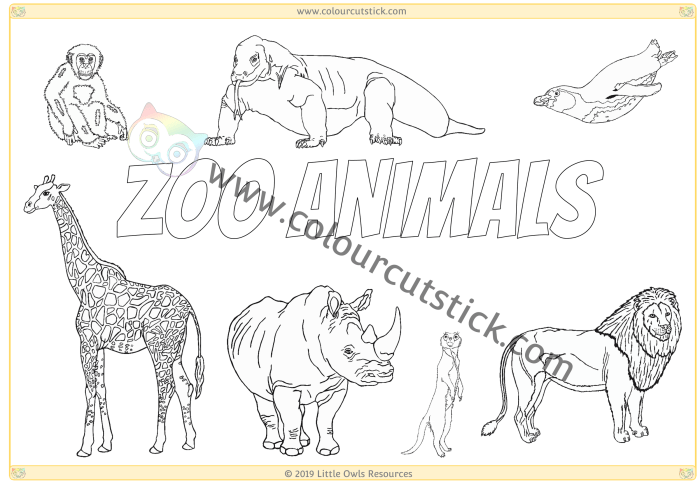Creating Your Own Zoo Animal Coloring Pages

Coloring pages zoo animals – Designing your own zoo animal coloring pages offers a personalized creative outlet and provides unique coloring experiences. This process involves several steps, from initial concept and sketching to final digital rendering, ready for printing. Whether you’re an experienced artist or just starting out, creating your own coloring pages can be a rewarding endeavor.
Creating unique coloring pages involves various techniques for depicting zoo animals, ranging from freehand drawing to leveraging digital tools. The following sections will explore these methods and Artikel the process of transforming your artwork into printable coloring pages.
Drawing Zoo Animals for Coloring Pages
Drawing zoo animals for coloring pages requires focusing on clear Artikels and simplified shapes. Details like fur texture or complex shading should be avoided, as these can interfere with the coloring process. The goal is to create easily recognizable animal forms that provide ample space for coloring.
Freehand drawing allows for creative expression and personalization. Start by lightly sketching the basic shapes of the animal, gradually adding details like the head, legs, and tail. Reference images from books or online resources can be helpful for capturing accurate proportions and characteristic features. Once the sketch is complete, refine the lines with a darker pencil or pen to create a clear Artikel.
Tracing is another useful method, especially for beginners. Print out a simplified image of the desired zoo animal and place it under a sheet of tracing paper. Carefully trace the Artikel of the animal, focusing on creating smooth, continuous lines. This method helps develop drawing skills while ensuring accurate representation of the animal.
Digitizing Hand-Drawn Illustrations
Transforming hand-drawn illustrations into digital coloring pages allows for easy reproduction and distribution. This process involves scanning the artwork and using image editing software to refine and prepare it for printing.
The first step is to scan your drawing at a high resolution (at least 300 dpi) to capture the details and ensure a crisp final image. Save the scanned image as a JPEG or PNG file. Next, open the image in a graphics editing program like GIMP or Photoshop. Use the software’s tools to adjust the contrast and brightness, ensuring the lines are dark and distinct against a white background.
The “erase” or “magic wand” tool can be used to remove any stray marks or smudges. Finally, save the cleaned-up image as a PDF for optimal printing quality.
Illustrating Zoo Animals for Coloring Pages: Coloring Pages Zoo Animals

Creating engaging coloring pages for children involves careful consideration of the subject matter and its presentation. Zoo animals are a popular choice, offering a variety of shapes, patterns, and poses that can spark creativity. Illustrating these animals requires a balance of realism and simplification to ensure the final product is both recognizable and easy to color.
Lion Illustration for Coloring Pages, Coloring pages zoo animals
The majestic lion presents a compelling subject for a coloring page. Its distinctive features require careful attention to create a recognizable and enjoyable coloring experience.The lion’s mane should be depicted as a thick, flowing mass around the head and shoulders. Individual clumps and strands can be suggested to create texture and allow children to add their own details.
Avoid overly intricate details, as this can make coloring difficult. The facial features should be clearly defined. Large, almond-shaped eyes, a prominent nose, and a strong jawline are key characteristics. The expression can range from regal serenity to a playful grin, depending on the intended audience. The overall posture should convey a sense of power and grace.
A seated lion with its head held high can communicate majesty, while a playful cub might be depicted in a more dynamic pose.
Giraffe Illustration for Coloring Pages
The giraffe’s unique physique provides a fascinating challenge for coloring page illustrations. Its height, long neck, and distinctive pattern are key elements to emphasize.The giraffe’s long neck should be depicted with a gentle curve, avoiding overly straight or stiff lines. The body should be slender and proportionate to the neck and legs. The pattern is a crucial aspect of the giraffe’s appearance.
Large, irregular patches of varying shapes and sizes should be clearly defined, providing ample space for coloring. Simpler patterns are generally preferable for younger children, while older children might enjoy more complex designs.
Playful Monkey Illustration for Coloring Pages
Monkeys, with their active nature and expressive faces, are a delightful subject for coloring pages. Capturing their playful spirit requires attention to pose and expression.A playful monkey might be depicted swinging from a branch, hanging upside down, or interacting with another monkey. The pose should be dynamic and engaging, conveying a sense of movement and energy. The monkey’s expression is crucial to conveying its playful nature.
Wide eyes, a mischievous grin, or a slightly open mouth can suggest curiosity and amusement. The hands and feet should be clearly defined, as they are often involved in the monkey’s activities. The fur can be depicted with simple lines or textures, allowing children to add their own details with color.
Coloring pages featuring zoo animals offer a fun way to learn about different species. For a walk on the wild side, explore jungle animals coloring pages featuring vibrant creatures like tigers and monkeys. Returning to the zoo theme, consider creating a colorful habitat collage with your finished animal pages.
